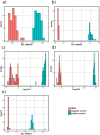Statistical Evaluation of HTS Assays for Enzymatic Hydrolysis of β-Keto Esters
- PMID: 26730596
- PMCID: PMC4711668
- DOI: 10.1371/journal.pone.0146104
Statistical Evaluation of HTS Assays for Enzymatic Hydrolysis of β-Keto Esters
Abstract
β-keto esters are used as precursors for the synthesis of β-amino acids, which are building blocks for some classes of pharmaceuticals. Here we describe the comparison of screening procedures for hydrolases to be used for the hydrolysis of β-keto esters, the first step in the preparation of β-amino acids. Two of the tested high throughput screening (HTS) assays depend on coupled enzymatic reactions which detect the alcohol released during ester hydrolysis by luminescence or absorption. The third assay detects the pH shift due to acid formation using an indicator dye. To choose the most efficient approach for screening, we assessed these assays with different statistical methods-namely, the classical Z'-factor, standardized mean difference (SSMD), the Kolmogorov-Smirnov-test, and t-statistics. This revealed that all three assays are suitable for HTS, the pH assay performing best. Based on our data we discuss the explanatory power of different statistical measures. Finally, we successfully employed the pH assay to identify a very fast hydrolase in an enzyme-substrate screening.
Conflict of interest statement
Figures




Similar articles
-
High-throughput screening method for lipases/esterases.Methods Mol Biol. 2012;861:89-100. doi: 10.1007/978-1-61779-600-5_5. Methods Mol Biol. 2012. PMID: 22426713
-
A Microtiter Plate-Based Assay to Screen for Active and Stereoselective Hydrolytic Enzymes in Enzyme Libraries.Methods Mol Biol. 2017;1539:197-204. doi: 10.1007/978-1-4939-6691-2_11. Methods Mol Biol. 2017. PMID: 27900690
-
Mixed carbonates as useful substrates for a fluorogenic assay for lipases and esterases.Chembiochem. 2015 Mar 2;16(4):677-82. doi: 10.1002/cbic.201402528. Epub 2015 Feb 3. Chembiochem. 2015. PMID: 25648400
-
Functional-Based Screening Methods for Detecting Esterase and Lipase Activity Against Multiple Substrates.Methods Mol Biol. 2018;1835:109-117. doi: 10.1007/978-1-4939-8672-9_4. Methods Mol Biol. 2018. PMID: 30109647 Review.
-
Physicochemical aspects of the enzymatic hydrolysis of carboxylic esters.Pharmazie. 2002 Feb;57(2):87-93. Pharmazie. 2002. PMID: 11878195 Review.
Cited by
-
Developing a fluorometric urease activity microplate assay suitable for automated microbioreactor experiments.Front Bioeng Biotechnol. 2022 Sep 14;10:936759. doi: 10.3389/fbioe.2022.936759. eCollection 2022. Front Bioeng Biotechnol. 2022. PMID: 36185447 Free PMC article.
-
Riboswitching with ciprofloxacin-development and characterization of a novel RNA regulator.Nucleic Acids Res. 2018 Feb 28;46(4):2121-2132. doi: 10.1093/nar/gkx1319. Nucleic Acids Res. 2018. PMID: 29346617 Free PMC article.
-
β-Phenylalanine Ester Synthesis from Stable β-Keto Ester Substrate Using Engineered ω-Transaminases.Molecules. 2018 May 18;23(5):1211. doi: 10.3390/molecules23051211. Molecules. 2018. PMID: 29783679 Free PMC article.
-
Enzyme Benchmarking with Polyethylene Furanoate Soluble Scaffolds for Directed Evolution of PEFases.ACS Omega. 2024 Nov 1;9(45):45633-45640. doi: 10.1021/acsomega.4c09053. eCollection 2024 Nov 12. ACS Omega. 2024. PMID: 39554451 Free PMC article.
-
Design of Experiments As a Tool for Optimization in Recombinant Protein Biotechnology: From Constructs to Crystals.Mol Biotechnol. 2019 Dec;61(12):873-891. doi: 10.1007/s12033-019-00218-x. Mol Biotechnol. 2019. PMID: 31664704 Review.
References
-
- Liljeblad A, Kanerva LT. Biocatalysis as a profound tool in the preparation of highly enantiopure β-amino acids. Tetrahedron. 2006. June;62(25):5831–5854. Available from: http://www.sciencedirect.com/science/article/pii/S0040402006005412. 10.1016/j.tet.2006.03.109 - DOI
-
- Umezawa H, Maeda K, Takeuchi T OY. New antibiotics, bleomycin A and B. The Journal of Antibiotics (Tokyo). 1966;19:200–209. - PubMed
Publication types
MeSH terms
Substances
LinkOut - more resources
Full Text Sources
Other Literature Sources

